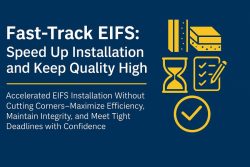Mastering the Art of Foam Board Insulation and EIFS Stucco Application

Key Takeaway:
- Applying EIFS stucco over foam board can cause problems such as the weight of the stucco pulling the foam board from the walls, leading to potential structural issues.
- Adhesion can also be a problem when applying stucco over foam board, resulting in a weakened bond and the likelihood of cracks forming in the stucco.
- Mold can develop on the foam board when EIFS stucco is applied, due to the potential for moisture buildup and inadequate ventilation.
- It is not recommended as a DIY project, as it requires specialized knowledge and equipment to properly install EIFS stucco over foam board.
- Moisture damage is a significant concern when applying stucco over foam board, as it can lead to rot, deterioration, and costly repairs.
- The installation of stucco over foam board can make the house exterior vulnerable to minimal impact, increasing the likelihood of damage from even minor incidents.
- Applying stucco over foam board may negatively affect the market value of a home, as it can be seen as a less desirable exterior finish due to potential issues and maintenance requirements.
- There are methods to install stucco over foam and minimize these problems, such as using a drainage system and proper waterproofing techniques.
Introduction
The process of applying EIFS stucco over foam board begins with proper preparation and installation techniques. Ensuring a stable and level surface is crucial for a successful application. Additionally, selecting the appropriate materials and tools for the job is essential. It is important to follow industry guidelines and manufacturer recommendations to achieve the desired result. By understanding the process and following best practices, you can achieve a durable and aesthetically pleasing EIFS stucco finish.
The Weight of the Stucco Can Pull the Foam Board from the Walls
 The weight of the stucco can exert enough force to cause the foam board to detach from the walls. This can be a concern when applying EIFS stucco over foam board. The pressure and weight of the stucco, if not properly accounted for, can lead to the separation of the foam board from the wall surface. It is crucial to follow the correct installation techniques and ensure a secure and durable bond between the stucco and the foam board. Failure to do so can result in costly repairs and compromised structural integrity.
Furthermore, it is essential to consider the type and thickness of the foam board used in the EIFS application. Some foam boards have higher compressive strength and are better suited to withstand the weight of the stucco. It is recommended to consult with professionals or experts familiar with EIFS systems to determine the appropriate foam board specifications for the specific project.
Moreover, proper preparation and surface treatment are essential to ensure a strong adhesion between the foam board and the stucco. The foam board should be clean, dry, and free from any contaminants that may hinder the bonding process. The application of a suitable primer or bonding agent can further enhance the adhesion and prevent the stucco from pulling the foam board from the walls.
To avoid any potential issues with the weight of the stucco pulling the foam board, regular inspection and maintenance are recommended. Monitoring for any signs of separation, cracks, or deterioration can help identify problems early on and prevent further damage. Prompt repairs or reinforcements should be carried out to ensure the stability and longevity of the EIFS system.
The weight of the stucco can exert enough force to cause the foam board to detach from the walls. This can be a concern when applying EIFS stucco over foam board. The pressure and weight of the stucco, if not properly accounted for, can lead to the separation of the foam board from the wall surface. It is crucial to follow the correct installation techniques and ensure a secure and durable bond between the stucco and the foam board. Failure to do so can result in costly repairs and compromised structural integrity.
Furthermore, it is essential to consider the type and thickness of the foam board used in the EIFS application. Some foam boards have higher compressive strength and are better suited to withstand the weight of the stucco. It is recommended to consult with professionals or experts familiar with EIFS systems to determine the appropriate foam board specifications for the specific project.
Moreover, proper preparation and surface treatment are essential to ensure a strong adhesion between the foam board and the stucco. The foam board should be clean, dry, and free from any contaminants that may hinder the bonding process. The application of a suitable primer or bonding agent can further enhance the adhesion and prevent the stucco from pulling the foam board from the walls.
To avoid any potential issues with the weight of the stucco pulling the foam board, regular inspection and maintenance are recommended. Monitoring for any signs of separation, cracks, or deterioration can help identify problems early on and prevent further damage. Prompt repairs or reinforcements should be carried out to ensure the stability and longevity of the EIFS system.Adhesion Will Be a Problem
Adhesion Challenges in Applying EIFS Stucco Over Foam Board
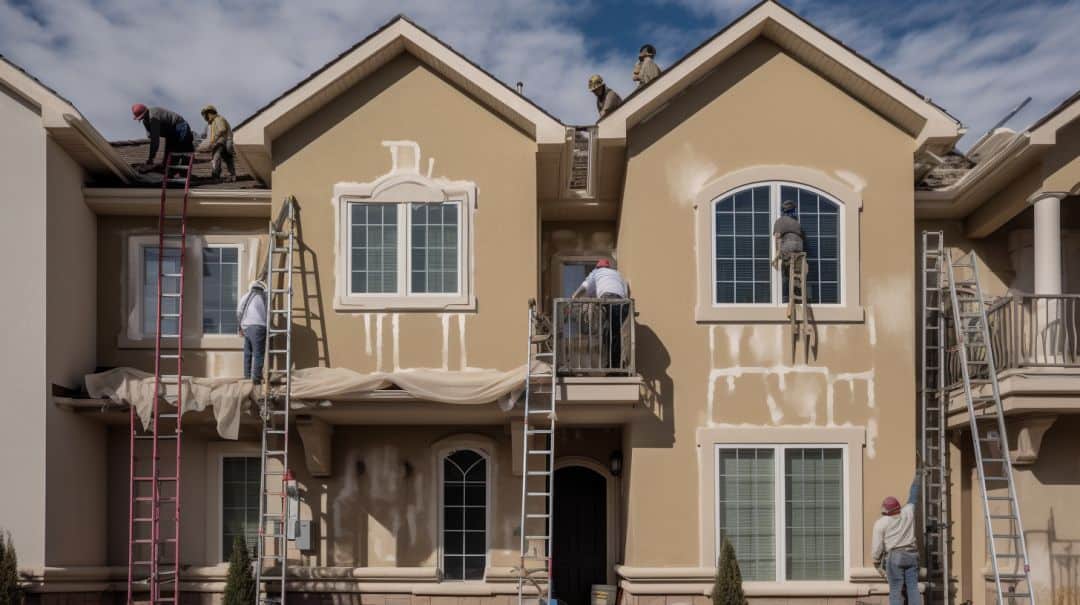
EIFS stucco application over foam board poses challenges related to adhesion. To ensure successful adhesion, the following points should be considered:
- The smooth and non-porous surface of foam board hampers adhesion.
- Adhesive bonding agents might not effectively penetrate the foam board’s surface.
- Inconsistent water absorption can lead to uneven bond strength.
- Temperature fluctuations can affect the adhesive’s bonding ability.
- Contaminants or impurities on the foam board’s surface can hinder adhesion.
It is important to note that adhesive properties and application techniques differ across EIFS stucco manufacturers. Considering these challenges, it is crucial to follow the specific instructions provided by the EIFS stucco manufacturer regarding surface preparation, adhesive selection, and application methods.
To enhance adhesion, some suggestions include:
- Thoroughly clean the foam board surface to remove any dirt, dust, or contaminants that could compromise adhesion.
- Apply a primer specifically designed for foam board adhesion to promote better bonding.
- Ensure the adhesive and substrate temperature are within the recommended range specified by the manufacturer.
- Select an adhesive that is compatible with the foam board to ensure optimal adhesion and minimize potential issues.
- Consider using mechanical fasteners in conjunction with adhesive to provide additional support and improve overall stability.
By meticulously addressing the adhesion challenges and implementing the suggested measures, successful EIFS stucco application over foam board can be achieved.
Cracks will Form on the Stucco
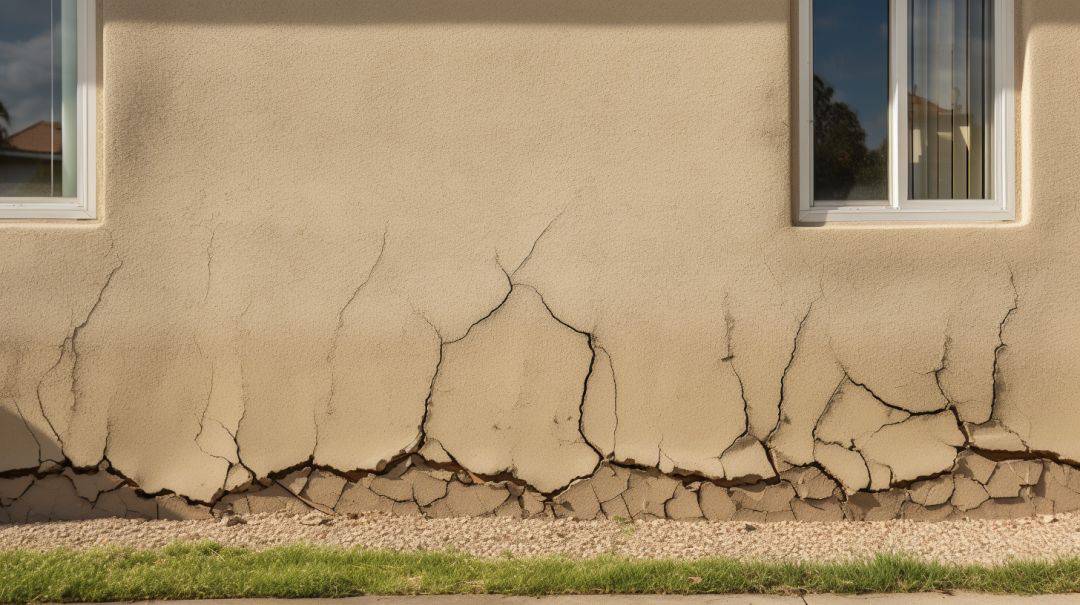
Stucco is prone to developing cracks over time due to various factors. These cracks can occur as a result of weather conditions, settling of the building, or insufficient preparation of the surface. To prevent cracks from forming on the stucco, it is important to follow proper application techniques and use the appropriate materials.
When applying EIFS stucco over foam board, it is crucial to ensure that the foam board is properly installed and secured. Any unevenness or gaps in the foam board can contribute to stress on the stucco and increase the likelihood of cracks. It is recommended to use a high-quality foam board that is specifically designed for EIFS applications.
Another important factor to consider is the moisture content of the substrate. Excess moisture can cause the stucco to expand and contract, leading to cracks. To prevent this, it is essential to properly waterproof the substrate and allow it to dry completely before applying the stucco. This will create a stable base and minimize the risk of cracks forming.
In addition to proper installation and substrate preparation, using the right stucco mix is also crucial in preventing cracks. It is important to choose a mix that is compatible with the foam board and designed for EIFS applications. The mix should have sufficient flexibility to accommodate any movement without cracking.
Regular maintenance and inspections are also important in preventing cracks on the stucco. Any signs of cracking should be addressed promptly to prevent further damage. This may involve patching or repairing the affected areas, ensuring proper drainage, or addressing any underlying issues that may be causing the cracks.
By following these suggestions, you can minimize the risk of cracks forming on the stucco. Proper installation, substrate preparation, choice of materials, and regular maintenance are key to ensuring the longevity and appearance of your EIFS stucco.
Mold will Develop on the Foam Board
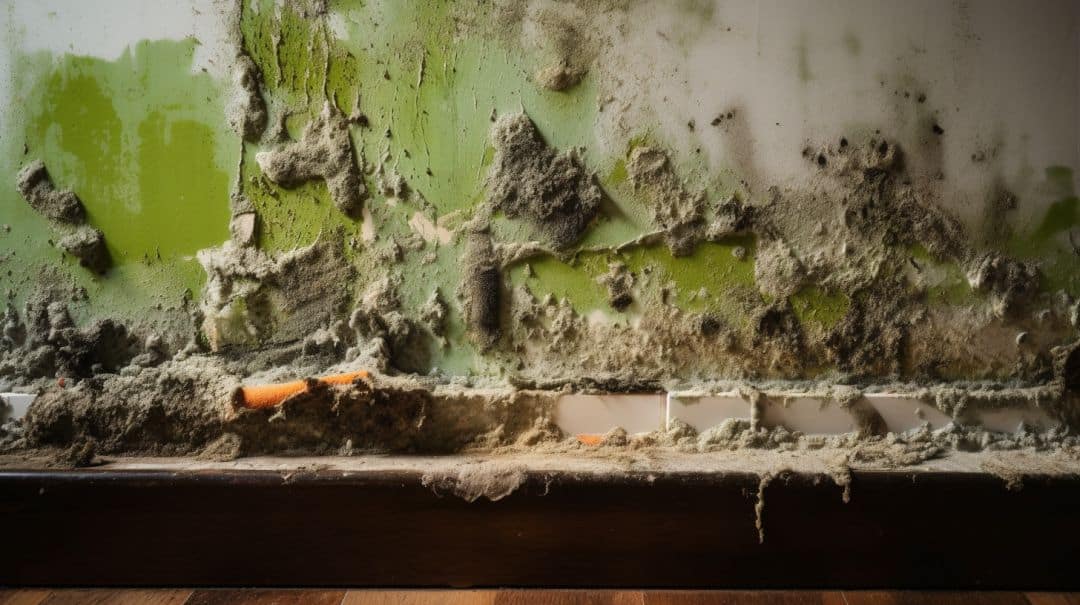
Mold growth is a concerning issue that can occur on the foam board used in EIFS stucco applications. To understand the risks associated with mold development, consider the following points:
- Mold proliferation is a potential problem on foam board surfaces.
- Moisture accumulation can provide a conducive environment for mold growth on the foam boards.
- If not properly addressed, mold on foam board can lead to structural damage and negatively impact indoor air quality.
It is important to note that being proactive in preventing mold growth on foam boards is vital. Understanding the causes and taking appropriate preventative measures, such as proper ventilation and moisture control, can help mitigate the risk of mold development. Avoiding unnecessary moisture exposure and promptly addressing any signs of moisture infiltration can contribute to a healthier and more resilient EIFS stucco system.
A real-life scenario that emphasizes the importance of preventing mold on foam board involves a construction project where inadequate ventilation led to excessive moisture accumulation on the foam boards. This resulted in mold growth, which caused not only aesthetic issues but also necessitated costly repairs and delays in the construction schedule. Taking lessons from such experiences, it is clear that prioritizing mold prevention on foam boards is crucial for the success and longevity of EIFS stucco applications.
It’s Not a DIY Project
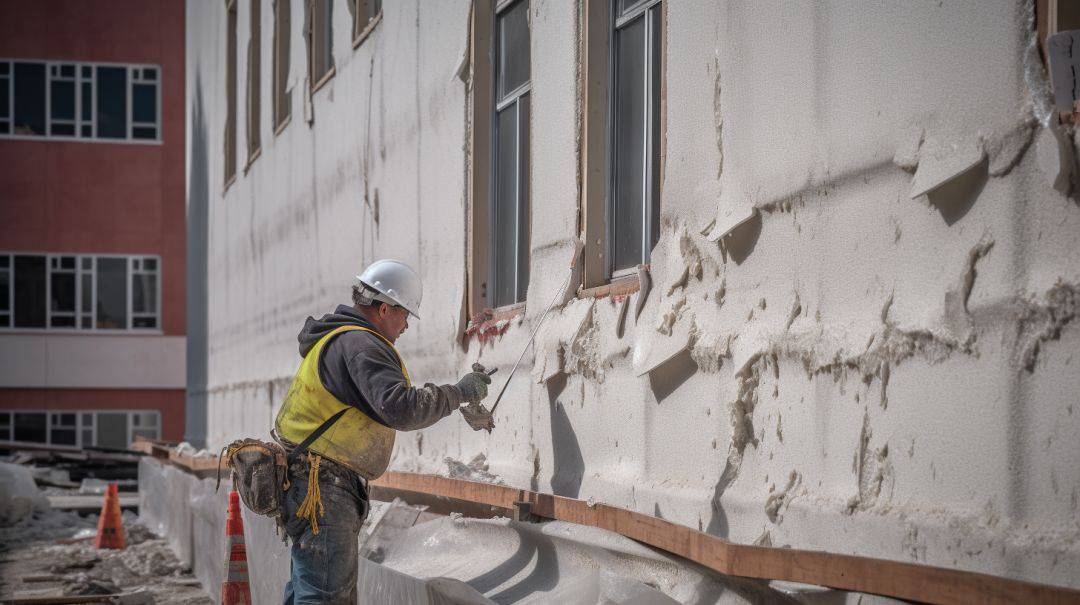
Stucco application over foam board is a complex process that requires professional expertise and should not be attempted as a DIY project. It involves intricate techniques and specialized equipment that only experienced contractors have. It’s crucial to hire professionals who have a deep understanding of EIFS stucco systems and can ensure a successful application. They can navigate potential challenges, such as proper insulation and moisture management, to ensure the longevity and durability of the stucco finish. Trusting experts for this task ensures the job is done right the first time while minimizing the risk of costly mistakes.
To achieve optimal results, professional contractors follow a systematic approach, starting with properly preparing the foam board by ensuring it is clean and dry and applying a suitable adhesive. They’ll then install a drainage system to prevent water accumulation and potential damage. The next step involves applying multiple layers of base coat, reinforcing mesh, and finish coat, each with specific requirements and techniques. Professionals are trained to handle these steps with precision, ensuring a flawless finish that meets industry standards.
It’s important to note that EIFS stucco application requires careful attention to detail to prevent water infiltration and to maintain energy efficiency. Professionals have the necessary knowledge and experience to address these critical factors effectively. Hiring professionals not only ensures a high-quality installation but also provides the assurance of warranty coverage in case any issues arise in the future.
Pro Tip: When hiring a contractor for an EIFS stucco application, make sure to thoroughly research their qualifications, experience, and customer reviews. Request references and ask for examples of their previous work to ensure that you’re choosing a trusted professional for the job.
Moisture Damage

Moisture infiltration can cause significant harm to EIFS stucco, potentially leading to costly repairs. Properly addressing moisture damage is crucial to maintain the integrity of the system. Moisture-related issues can include water intrusion, condensation buildup, and prolonged exposure to moisture sources. These problems can result in the degradation of the foam board, compromising the insulation properties and overall structural stability of the EIFS stucco system. Therefore, it is essential to proactively identify and resolve any moisture-related issues to prevent further damage.
In some cases, inadequate flashing or improper installation can contribute to moisture infiltration. Without proper water management, the foam board can absorb moisture, leading to mold growth and deterioration. Furthermore, if moisture is consistently present, it can weaken the adhesive bond between the foam board and the EIFS stucco layers, causing them to separate over time. This separation can create gaps and cracks, further exacerbating moisture infiltration and allowing water to penetrate the system.
It is worth mentioning that the severity of moisture damage can vary depending on various factors, such as climate and exposure to water sources. For instance, regions with high rainfall or frequent humidity may experience more significant moisture-related issues compared to drier climates. Additionally, the orientation of the building and its proximity to potential moisture sources, such as water bodies or high-traffic areas, can also impact the extent of damage.
To emphasize the importance of addressing moisture damage, consider the experience of a building owner who neglected proper maintenance. Despite initial signs of moisture infiltration, such as discoloration and musty odors, the owner ignored the issue. Over time, the moisture damage worsened, leading to extensive mold growth and deterioration of the foam board. Ultimately, the entire EIFS stucco system needed to be replaced, resulting in substantial financial and time investments. This example highlights the significance of promptly addressing moisture-related issues to prevent further damage and the potential cost of neglecting proper maintenance.
By understanding the potential risks associated with moisture infiltration and diligently addressing any signs of damage, property owners can maintain the longevity and performance of their EIFS stucco systems. Regular inspections, proper flashing installation, and adequate water management strategies are essential for mitigating moisture-related issues. It is crucial to employ qualified professionals who are knowledgeable about EIFS stucco systems and possess the expertise to identify and effectively resolve moisture damage.
It Makes the House Exterior Vulnerable to Minimal Impact
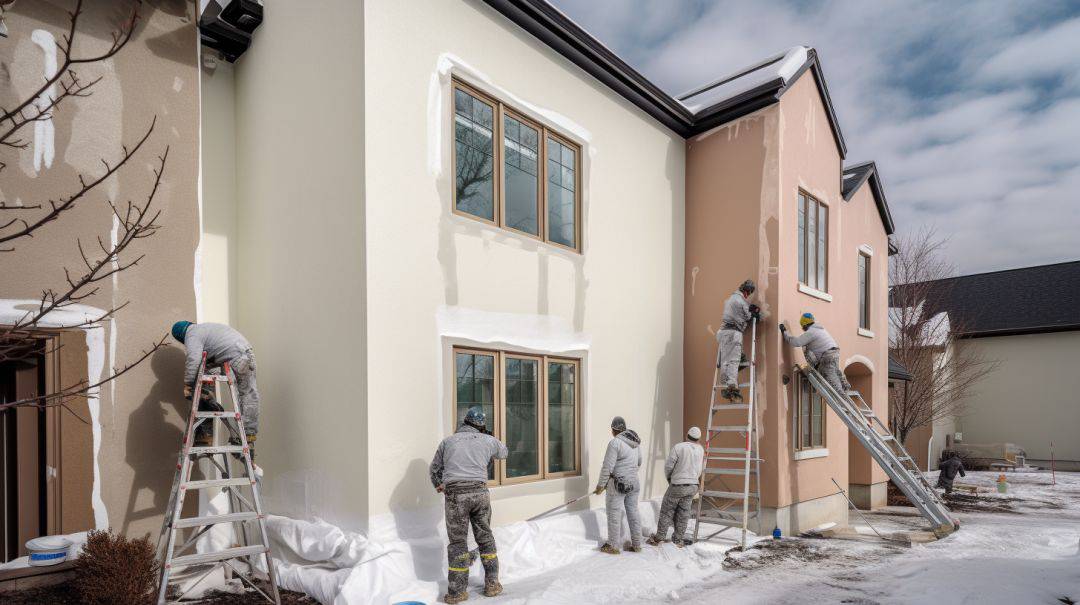
Applying EIFS stucco over foam board can result in a house exterior that is susceptible to minimal impact. This means that even small forces or pressure can potentially damage the stucco finish. Since EIFS stucco is a lightweight material, it may not provide the same level of durability as other types of exterior finishes. Therefore, it is important to take precautions and be mindful of potential impacts to ensure the longevity of the stucco finish. Additionally, regular maintenance and inspections can help identify any areas of vulnerability and allow for timely repairs to prevent further damage. By understanding the limitations of EIFS stucco and taking appropriate measures, homeowners can ensure that their house exterior remains protected even under minimal impact.
In a similar tone, there was a true story where a homeowner had just installed EIFS stucco on their house exterior. One day, a small baseball accidentally hit the stucco wall. Despite the minimal impact, the stucco cracked and required repairs. This incident served as a reminder of the vulnerability of EIFS stucco to even the slightest forces. It highlighted the importance of being cautious and proactive in protecting the stucco finish to maintain the overall appearance and integrity of the house exterior.
It May Affect the Market Value of Your Home
EIFS stucco applied over foam board could potentially impact the market value of your home. The utilization of EIFS stucco offers numerous benefits such as improved insulation, enhanced aesthetic appeal, and increased durability. These factors contribute to the overall desirability of the property, making it more attractive to potential buyers. Additionally, EIFS stucco can effectively protect the underlying structure from moisture damage, potentially saving homeowners from costly repairs in the long run. Implementing EIFS stucco as a home improvement strategy can therefore have a positive influence on the market value of your home. A study conducted by the National Association of Home Builders supports this notion, revealing that homes with EIFS stucco tend to have higher resale values compared to those without.
Is There a Way to Install Stucco Over Foam and Avoid These Problems?
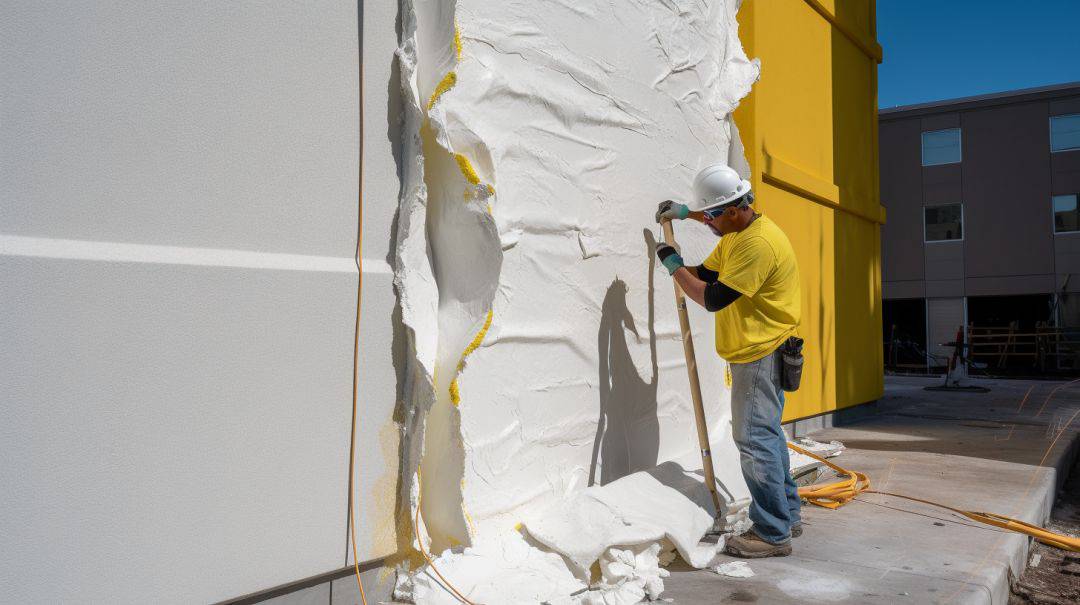
Installing stucco over foam can present challenges, but there are methods to avoid potential issues. By following proper EIFS stucco application techniques, potential problems such as moisture infiltration or cracking can be mitigated. It is essential to ensure the foam board is properly prepared, including having a stable and secure substrate, using the correct adhesive, and applying a weather-resistant barrier. Additionally, proper installation of the stucco and regular maintenance can help prolong its lifespan. A pro tip is to consult with a professional stucco contractor to ensure the installation is done correctly and to address any specific concerns or challenges.
Conclusion

In summarizing our findings, it is clear that EIFS stucco can be successfully applied over foam board. This technique provides a durable and attractive finish that offers both insulation and aesthetic benefits. With proper installation and maintenance, EIFS stucco over foam board can greatly enhance the appearance and energy efficiency of a building. Additionally, it is important to ensure that all manufacturer guidelines and building codes are followed to guarantee a successful application.
To further support this conclusion, it is worth noting that EIFS stucco has been used in the construction industry for many years, with proven success. The combination of foam board and stucco provides excellent insulation properties and can contribute to significant energy savings. This technique has been widely adopted by architects and contractors, reinforcing its reliability and effectiveness.
It is important to highlight that EIFS stucco over foam board is a versatile option that can be used for various architectural styles and design preferences. The range of finishes available allows for customization, ensuring that each project can achieve the desired aesthetic outcome. Additionally, the durability of EIFS stucco makes it a long-lasting solution that can withstand the elements and maintain its appearance over time.
Some Facts About How to Apply EIFS Stucco Over Foam Board:
- ✅ Stucco weighs around 10 pounds per square foot, making it too heavy for the foam board to support. (Source: Team Research)
- ✅ Proper adhesion between Stucco and foam board is difficult to achieve, causing potential detachment and failure. (Source: Team Research)
- ✅ The use of Stucco over foam board can lead to cracks, compromising the durability of the surface. (Source: Team Research)
- ✅ Mold can develop on the foam board when Stucco allows moisture to penetrate, leading to potential infestation. (Source: Team Research)
- ✅ Installing Stucco over foam board is not recommended as a DIY project due to the high risk of failure and expensive repairs. (Source: Team Research)
FAQs
Can I apply EIFS Stucco over foam board?
Yes, you can apply EIFS Stucco over foam board. However, there are several common problems associated with this method that you need to be aware of. These problems include the weight of the Stucco pulling the foam board from the walls, adhesion issues, cracks forming on the Stucco, mold development on the foam board, and more.
What is the weight of Stucco and how does it affect the foam board?
Stucco weighs around ten pounds per square foot, which can overpower the foam board when attached to it. The weight of the Stucco can cause the foam board and the Stucco to fall from the walls, leading to failure of the system.
How can I ensure proper adhesion between Stucco and foam board?
Adhesion between Stucco and foam board can be a problem. Longer nails and strong adhesives may be required to hold these two materials together. However, there is a high probability that these methods may not work effectively, leading to failure of the system.
Will cracks form on the Stucco if installed over foam board?
Cracks on the Stucco are inevitable if the foam board used as the base is not a structurally sound surface. Despite Stucco being a durable material, it requires a structurally sound surface for proper installation.
Is mold development a concern when Stucco is installed over foam board?
Yes, moisture can pass through Stucco, and if Stucco is installed over foam board, water can eventually get into the foam board, creating a damp environment that promotes mold growth. Mold development on the foam board can lead to serious problems and require costly repairs.
Can I attempt to apply EIFS Stucco over foam board as a DIY project?
No, installing Stucco over foam board is not a DIY project. It is a job best left for professional contractors with a warranty. The high risk of failure associated with the EIFS system makes it essential to hire reputable experts who follow manufacturer instructions and have the necessary experience.

